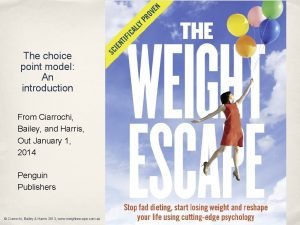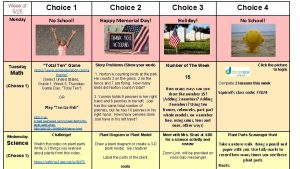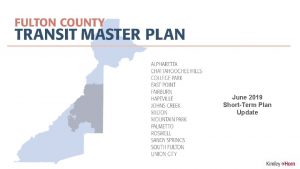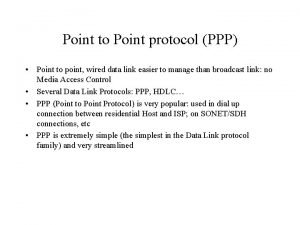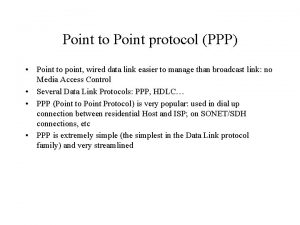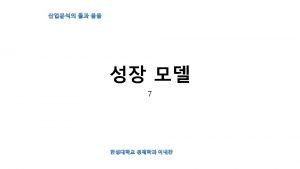The choice point model An introduction From Ciarrochi























- Slides: 23

The choice point model: An introduction From Ciarrochi, Bailey, and Harris, Out January 1, 2014 Penguin Publishers © Ciarrochi, Bailey & Harris 2013, www. weightescape. com. au

What is a choice point? A choice point is a moment in time when it is possible to choose between valuesconsistent and values inconsistent behavior. People are often unaware of choice points, so a key first task of the practitioner is to help them become aware In Man’s search for meaning, Victor Frankl argued that even in the most restrictive circumstances, even if you are in a concentration camp facing death, you still have the chance to make valued choices. “In between stimulus and response there is a space; in that space lies our power to choose our response; in our response lies our growth and our freedom. ” -Victor Frankl © Ciarrochi, Bailey & Harris 2013, www. weightescape. com. au

What is the choice point model ✤ ✤ ✤ The Choice Point is a simple way to help you and your client keep track of where you are in an ACT intervention. Indeed, we believe it is useful for just about any Contextual Behavioral Science intervention Lets walk through the choice point model now © Ciarrochi, Bailey & Harris 2013, www. weightescape. com. au

The choice point represents the present moment. At any given moment, we can choose to act in a value consistent or a value inconsistent way. The top may also be labeled “unworkable” and “Away” and “Towards. ” Note that “Away” and “Toward” here does not necessarily mean aversive versus appetitive. It refers to value inconsistent versus consistent action. Some avoidance may be value consistent, and some appetitive behavior may be value inconsistent. © Ciarrochi, Bailey & Harris 2013, www. weightescape. com. au

Now we add three things: The situation. What is the challenging situation you are facing? This is the antecedent. Inner experience. What difficult feelings, thoughts, and sensations show up in this situation? Values, Skills, and Strengths: What can you use to help you respond effectively to inner experience and to the challenge © Ciarrochi, Bailey & Harris 2013, www. weightescape. com. au

Example choice point for client with diabetes © Ciarrochi, Bailey & Harris 2013, www. weightescape. com. au

Introducing the choice point ✤ ✤ ✤ The client is told that this is a mindful, collaborative activity. You are helping the client to step back and look at his or her own life. You show the client the worksheet and get informed consent The therapist takes a mindful and exploratory stance. Only the client can determine what is value-consistent or inconsistent. Like all ACT interventions, therapeutic stance is one of compassion and equality. We all have our difficult choice points. © Ciarrochi, Bailey & Harris 2013, www. weightescape. com. au

Choice Point © Ciarrochi, Bailey & Harris 2013, www. weightescape. com. au

Temptation to eat something that has a lot of sugar (High GI) © Ciarrochi, Bailey & Harris 2013, www. weightescape. com. au

“I’m not feeling any symptoms, I’ll be ok I’ve worked hard all day, I deserve this. It’s all to hard. ” Cravings for sugar Temptation to eat something that has a lot of sugar (High GI) © Ciarrochi, Bailey & Harris 2013, www. weightescape. com. au

A special note about the health domain ✤ ✤ ✤ When we use the choice point in the health domain, we often seek to help clients identify the desired outcomes of their health behavior Then once they see the possible outcomes, we help them to identify how those outcomes will help their life in general, as in the forthcoming slide We can’t always obtain the outcomes we want. We help people to recognize this, and use the choice point model to define success not in terms of outcome, but in terms of value-consistent behavior. © Ciarrochi, Bailey & Harris 2013, www. weightescape. com. au

“I’m not feeling any symptoms, I’ll be ok I’ve worked hard all day, I deserve this. It’s all to hard. ” Cravings for sugar Desired health outcomes: having good immune function, having energy, thinking better, better physical functioning These help me to: painting, playing with grandkids, spending time with friends Temptation to eat something that has a lot of sugar (High GI) © Ciarrochi, Bailey & Harris 2013, www. weightescape. com. au

Follow diet plan Eat box donuts Monitor blood sugar Take walk in morning Forget to monitor Skip walk “I’m not feeling any symptoms, I’ll be ok I’ve worked hard all day, I deserve this. It’s all to hard. ” Cravings for sugar Desired health outcomes: having good immune function, having energy, thinking better, better physical functioning These help me to: painting, playing with grandkids, spending time with friends Temptation to eat something that has a lot of sugar (High GI) © Ciarrochi, Bailey & Harris 2013, www. weightescape. com. au

The following is an example skill that can be used in the Choice Point This is taken from Get Out of Your Mind and Into Your Life Teens, By Ciarrochi, Hayes, and Bailey, 2012 © Ciarrochi, Bailey & Harris 2013, www. weightescape. com. au

AT the choice point, be BOLD ✤ ✤ B- Breath—Breath slowly, slow down O-Observe—Observe what you are Doing. Feeling. Thinking. Allow inner experience to flow throw you. L-Listen to values--Right now, what kind of person do you want to be? D –Decide on actions and do them. Choose actions that will reflect your values © Ciarrochi, Bailey & Harris 2013, www. weightescape. com. au

What skills and strengths can you use to help live your values? ✤ ✤ You can state skills in terms of if-then statements. Here are some examples If _______________(difficult feelings) shows up, then I will use my BOLD skills , let the feelings come and go like weather, and choose my “value consistent” action If _______________(reason for not doing things) shows up, then I will use my BOLD skills and “never mind my mind. ” If_____________(external difficulty) comes up, then I will take the following steps to deal with the difficulty (use problem solving and write action plan here © Ciarrochi, Bailey & Harris 2013, www. weightescape. com. au

Follow diet plan Eat box donuts Monitor blood sugar Take walk in morning Forget to monitor Skip walk “I’m not feeling any symptoms, I’ll be ok I’ve worked hard all day, I deserve this. It’s all to hard. ” Cravings for sugar (Values inserted here) • If I’m telling myself I don’t need to monitor, I’ll use my BOLD skills to never mind these thoughts and monitor • If I have a sugar craving, I will eat a low GI treat or use BOLD to surf the craving Temptation to eat something that has a lot of sugar (High GI) © Ciarrochi, Bailey & Harris 2013, www. weightescape. com. au

Using Choice Point flexibly ✤ ✤ ✤ We have given you a demonstration of working through the choice point quickly with a client. You can also use it for more detailed work. The following diagrams show you how to use Choice Point when working with avoidance, willingness, defusion, self-compassion, and values We use Toward and Away in these diagrams but again this refers to value consistent and inconsistent behavior, not appetitive and aversive driven behavior. © Ciarrochi, Bailey & Harris 2013, www. weightescape. com. au

Emotional eating Avoid health behavior Comfort eating Procrastination Eating to assert Drinking, exercising Distraction, opting out, Suppression Anorexia, bulimia Avoid Stress, Lonely Afraid of illness, death Feeling uncared for, Angry Sad, Feeling out of control © Ciarrochi, Bailey & Harris 2013, www. weightescape. com. au

Stress, Lonely Afraid of illness, death Feeling uncared for, Angry Sad, Feeling out of control © Ciarrochi, Bailey & Harris 2013, www. weightescape. com. au Am I willing to have these feelings, in order to move “toward” what I want? If yes, then allow feelings to come and go like weather, breath in and around them, make space for them

I can’t do it, its too hard I’m not good enough I don’t deserve it My body is ugly What if I fail? I don’t have the motivation © Ciarrochi, Bailey & Harris 2013, www. weightescape. com. au Step back and observe your thoughts. Write them down. Play with them. Never mind your mind if it does not help you. Carry your mind and your thoughts as you move in valued way

Selfcompassion What’s wrong with me I always fail I’m weak I’ll never lose weight © Ciarrochi, Bailey & Harris 2013, www. weightescape. com. au • • Choosing self-kindness as a value and finding ways to put that value into play Recognizing that all people fail at their goals Making space for the self-criticism Recommitting to values

Free stuff The. Weight. Escape. com Acceptandchange. com © Ciarrochi, Bailey & Harris 2013, www. weightescape. com. au Available January 2014! Penguin Publisher s
 The choice point
The choice point Good choice or bad choice
Good choice or bad choice Las bases de datos mas grandes del mundo
Las bases de datos mas grandes del mundo Hát kết hợp bộ gõ cơ thể
Hát kết hợp bộ gõ cơ thể Lp html
Lp html Bổ thể
Bổ thể Tỉ lệ cơ thể trẻ em
Tỉ lệ cơ thể trẻ em Gấu đi như thế nào
Gấu đi như thế nào Tư thế worms-breton
Tư thế worms-breton Hát lên người ơi alleluia
Hát lên người ơi alleluia Môn thể thao bắt đầu bằng chữ đua
Môn thể thao bắt đầu bằng chữ đua Thế nào là hệ số cao nhất
Thế nào là hệ số cao nhất Các châu lục và đại dương trên thế giới
Các châu lục và đại dương trên thế giới Công thức tính thế năng
Công thức tính thế năng Trời xanh đây là của chúng ta thể thơ
Trời xanh đây là của chúng ta thể thơ Cách giải mật thư tọa độ
Cách giải mật thư tọa độ 101012 bằng
101012 bằng Phản ứng thế ankan
Phản ứng thế ankan Các châu lục và đại dương trên thế giới
Các châu lục và đại dương trên thế giới Thể thơ truyền thống
Thể thơ truyền thống Quá trình desamine hóa có thể tạo ra
Quá trình desamine hóa có thể tạo ra Một số thể thơ truyền thống
Một số thể thơ truyền thống Cái miệng nó xinh thế chỉ nói điều hay thôi
Cái miệng nó xinh thế chỉ nói điều hay thôi Vẽ hình chiếu vuông góc của vật thể sau
Vẽ hình chiếu vuông góc của vật thể sau
